Follow the instructions below to add a Data Protection Policy in Server Backup Manager. Note that when creating a new policy, an unassigned Disk Safe must be available for the protected machine that you select. To create a new Disk Safe, see Create Disk Safes.
1. In the Main Menu, click Settings and then Policies to open the Policies screen. Click the + New Policy button to add a new policy.
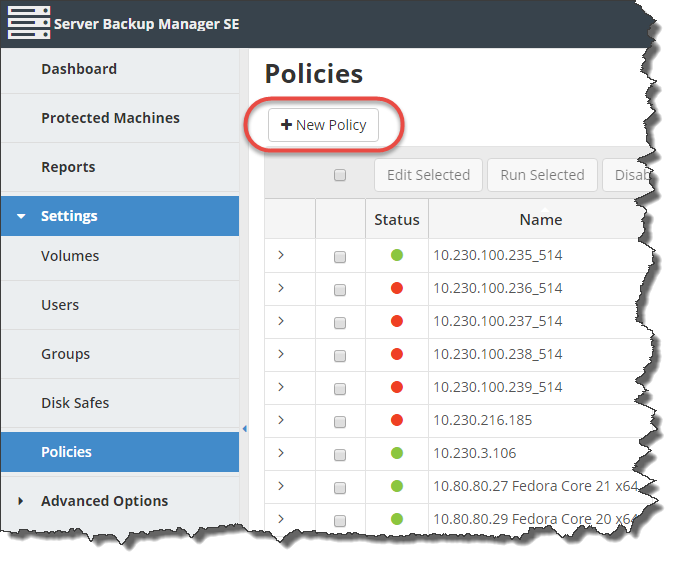
2. The Create New Policy window displays. It contains the following tabs:
- Policy Settings
- File Excludes
- Advanced Excludes
- SQL Server (only available for Windows agents)
- Exchange (only available for Windows agents)
- MySQL
- Control Panels
- Advanced Policy Settings
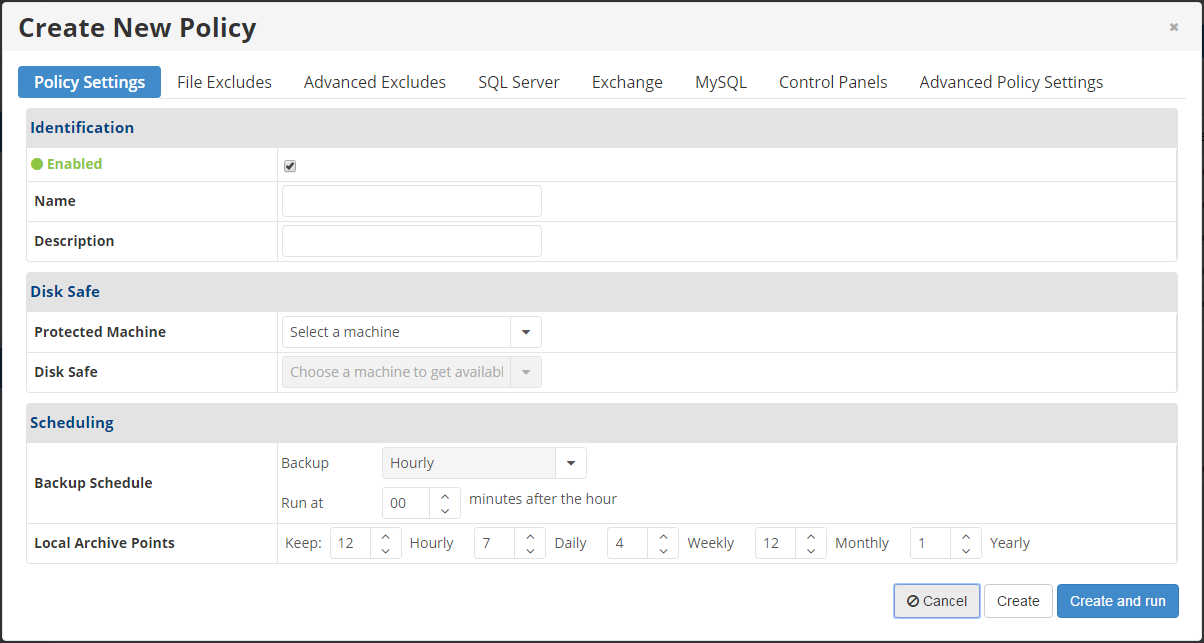
| Note Depending on the limits defined for the Disk Safe to which the current Policy is assigned, some of the tabs might be disabled. For more information about disabled tabs and Disk Safe limits, see Create Disk Safes. |
3. The Policy Settings tab is the main tab for creating a policy. Define the following settings specific to the new policy.
Identification
- Enabled. Select this check box to enable the policy once you are done creating it. The enabled policy will run according to the schedule. If you clear this check box, the policy will be created as disabled.
- Name. Enter a name you can use to identify this policy among others in the Policies list.
- Description. Describe your policy in detail. The description can be shown in the corresponding Details pane on the Policies screen.
Disk Safe
- Protected Machine. From the drop-down menu, select a protected machine whose data you are going to replicate. You will then be able to select a Disk Safe assigned to the machine.
- Disk Safe. From the drop-down menu, select an unassigned Disk Safe in which to save the replicated data.

Note
An unassigned Disk Safe must be available for the selected protected machine. For information on how to add a new Disk Safe, see Create Disk Safes.
Scheduling
- Backup Schedule. Defines the frequency and start time for the new Policy (On Demand, Minutely, Hourly, Daily, Weekly, Monthly or Yearly). See Backup schedule and recovery point retention policy

Note
The lowest possible Replication frequency for all the Disk Safes assigned to a Volume is defined in "Volume properties" ("Volume properties" window "Limits" tab
"Limits" tab  "Options" section
"Options" section  "Replication Limit" option).
"Replication Limit" option). - Retention Points. Defines the retention schedule for the recovery points.
4. In the File Excludes tab, you can manually exclude files and folders from the replication. For more information, see Exclude files and folders. 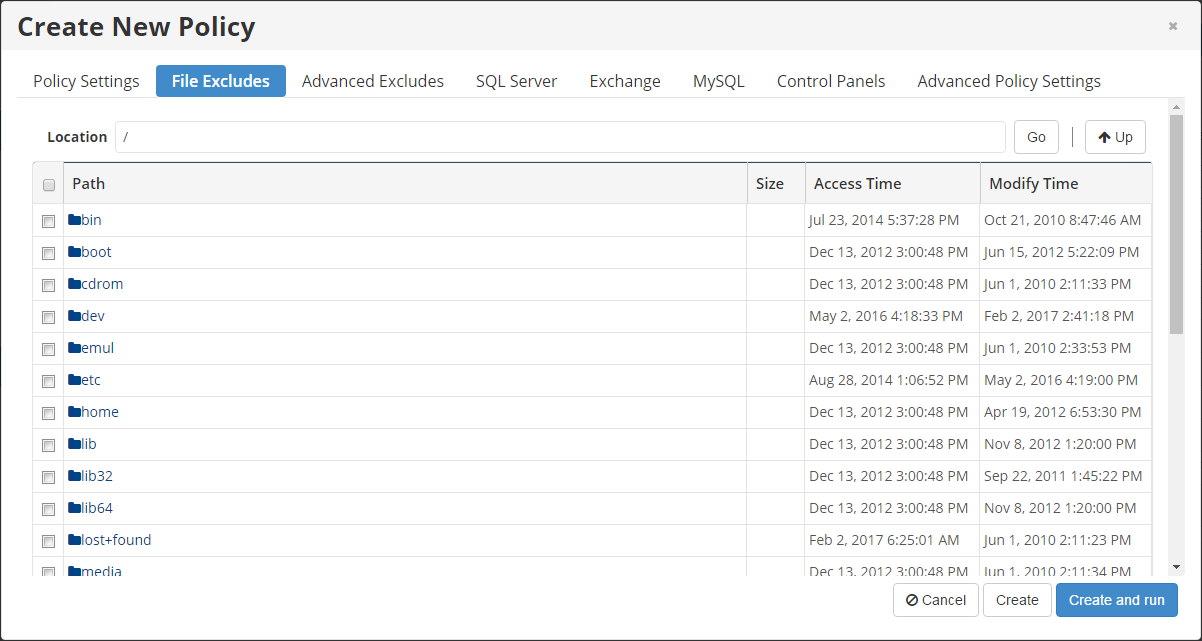
5. In the Advanced Excludes tab, you can define a pattern (mask) to exclude files from the replication. For more information, see Exclude files and folders.
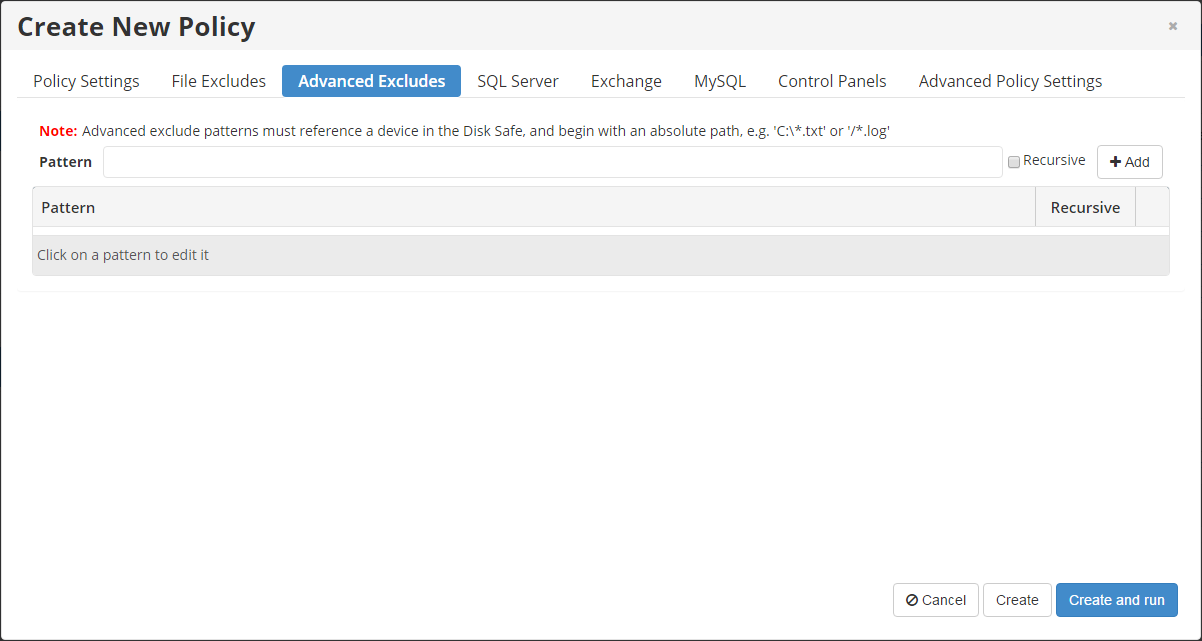
6. (Windows agents only) In the SQL Server tab, you can add a database instance to the policy. For more information, refer to Configure MS SQL server replication.
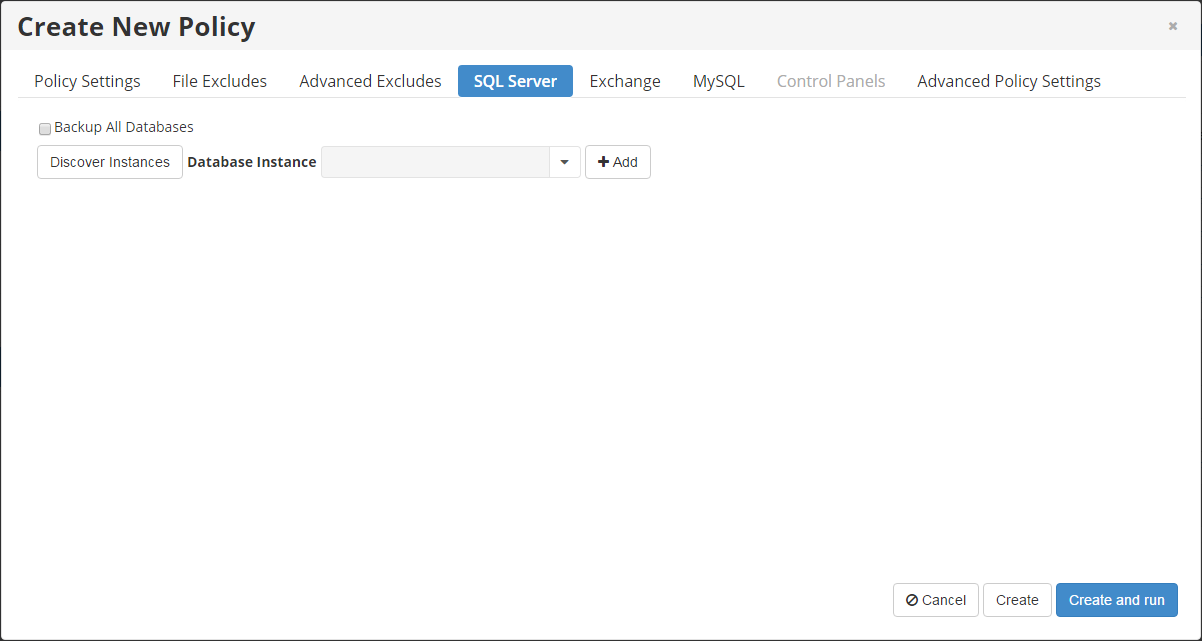
7. (Windows agents only) In the Exchange tab, you can configure an Exchange instance for the policy. For more information, see Configure an Exchange instance.
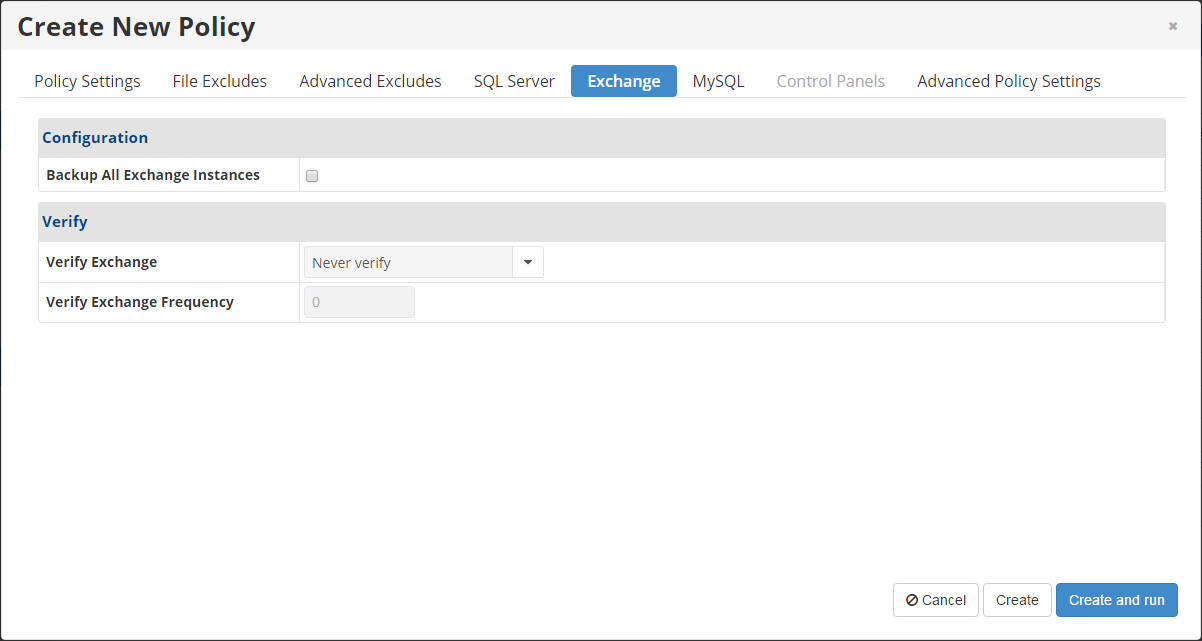
8. In the MySQL tab, you can add a MySQL instance to the policy. When you click the Add New MySQL Instance button, the Add Database Instance window displays.
For more information, see Add a MySQL instance to a policy.

9. In the Control Panels tab, you can add a control panel instance to your policy. When you click the Add Control Panel Instance button, the Add Control Panel Instance window displays.
For more information, see Add control panel instance.
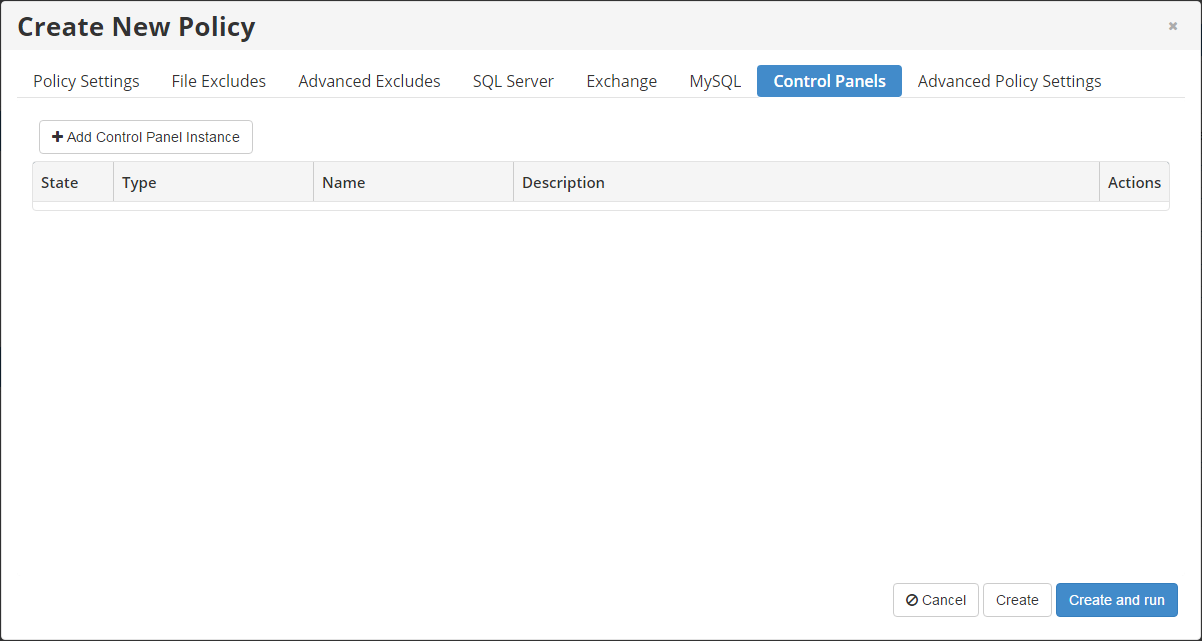
10. The Advanced Policy Settings tab contains all of your advanced policy settings. By default, the check boxes in this tab are all cleared.
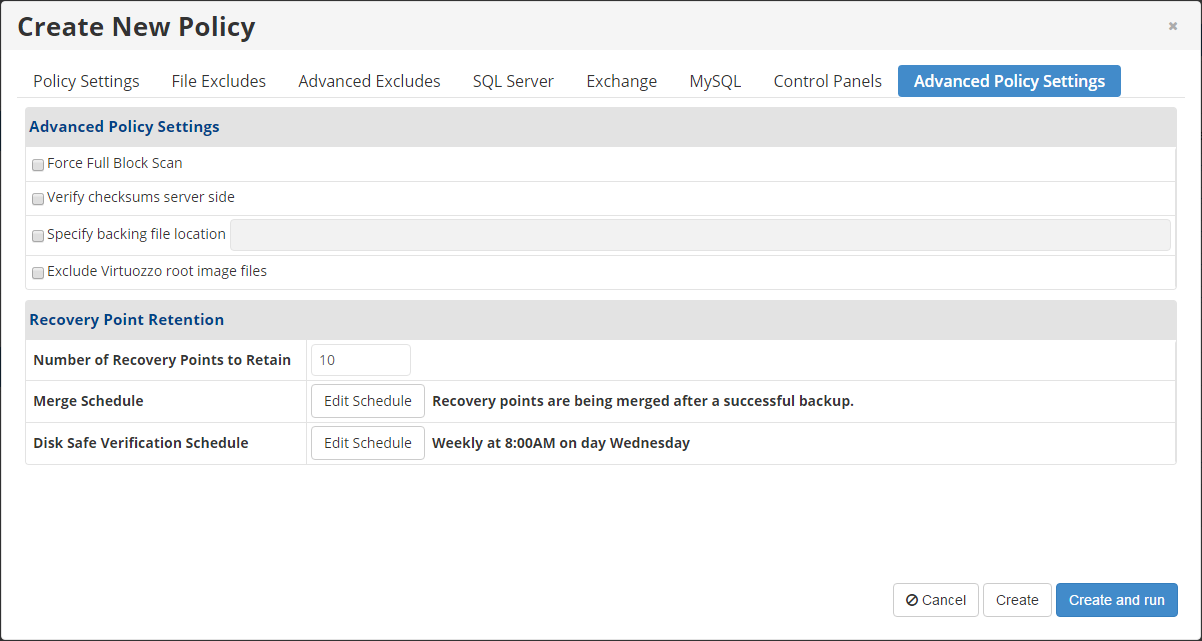
Define the following advanced settings specific to the new policy.
Advanced Policy Settings
- Force Full Block Scan. Select this option to mandate the start of a Full Block Scan each time the Replication is performed. If the option is not selected, then an automatic Full Block Scan occurs only under certain conditions. A Full Block Scan compares the MD5 sum of all allocated blocks to perform the backup and synchronize Server Backup. Read more in 3 Stages of CDP 3 Replication (Technical Papers).
- Verify checksums server side. Select this option to ensure that no data is lost during transporting. If this option is activated, then the server side uncompresses the data, unencrypts it if necessary, and compares block packet MD5 with data sent from the server. Verifying encrypted or unencrypted block checksums on server backup allows you to triple-check the integrity of a backup.
- Specify Backing File Location. (Linux only) Select this option to define a path to the mount point of a device that should be used to store changed blocks. This option is useful to support backups of devices with low free space. By default, the Linux snapshot driver stores changed blocks (needed to maintain snapshots) in the the free space of the file system on which it is performing a snapshot. When using a server with multiple disks, storing snapshots on a separate dedicated disk can help reduce the load during backup. The disk must have a file system and must be mounted.
| Example Linux system:
When /boot or /var is 99.99% full, the backups fail because there is no free space to maintain the snapshot. |
- Exclude Virtuozzo root image files. Select this option to exclude the Virtuozzo root image files from backing up.
- Exclude All Volume Shadow Copy Writers. (Windows only) Select this option if you temporarily want to exclude the Exchange and SQL Server databases from being backed up.
- Multi-Volume Snapshot. (Windows only) This option can be useful if the SQL Server or Exchange Server has files across more than one device. Note that if the SQL or Exchange Server has files across more than one Device and the Multi-Volume Snapshot option is not selected, the system displays an alert message.
Recovery Point Retention
- Number of Recovery Points to Retain. Enter the maximum number of recovery points to retain. The default is 10. The limit entered in this field cannot be greater than the limit defined for the current Disk Safe. For more information, see Create Disk Safes.
- Merge Schedule. Click the Edit Schedule button in this field to define the frequency and start time for Recovery Point merges (After successful replication, Hourly, Daily or Weekly). See Scheduling Recovery Point Merges.
- Disk Safe Verification Schedule. Click the Edit Schedule button in this field to define the frequency and start time for the Disk Safe verification (On Demand, Daily, Weekly or Monthly). See Scheduling Disk Safe Verification.
11. Click the Create button at the bottom of the Create New Policy window to create and add the policy to the Policies list. You can also click the Create and Run button to create the policy and run it immediately.
| Tip The task results can be sent via email as a report. See Reports. |
